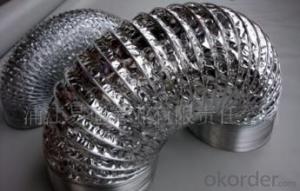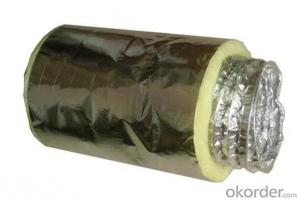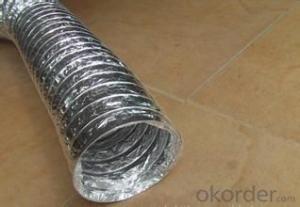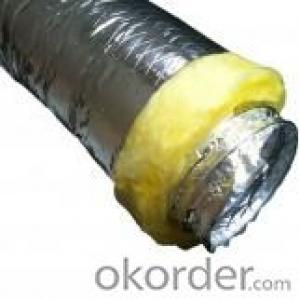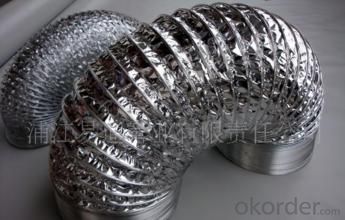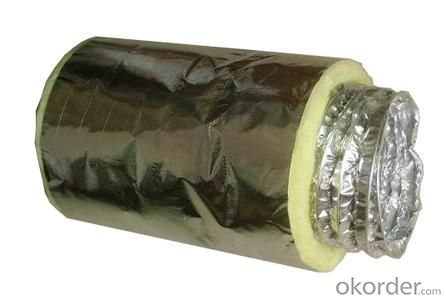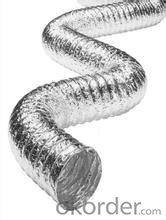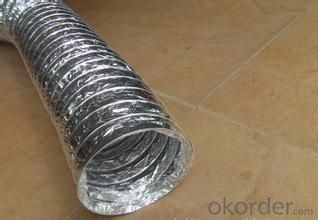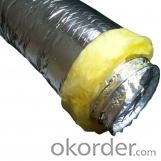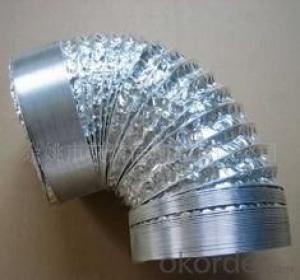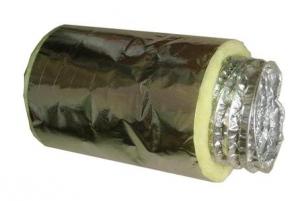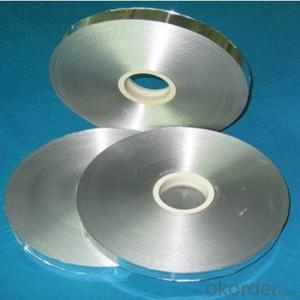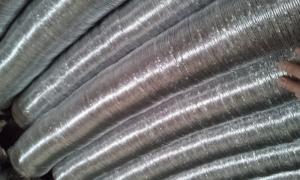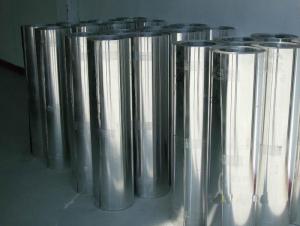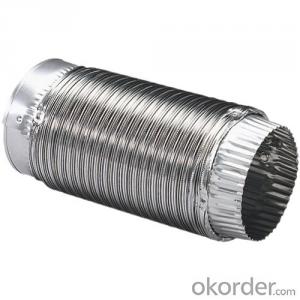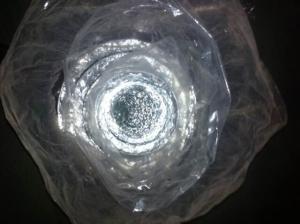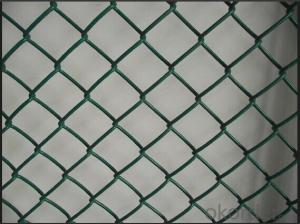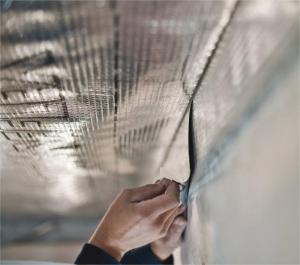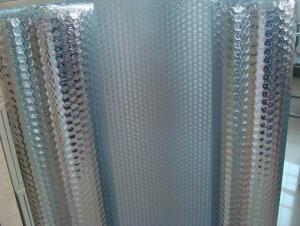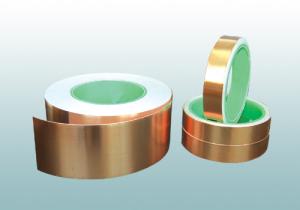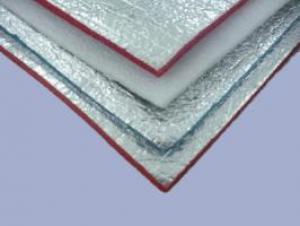Aluminum Foil Facing Insulated Flexible Ductings HVAC Ducting for Air Conditioning
- Loading Port:
- Shanghai
- Payment Terms:
- TT or LC
- Min Order Qty:
- 500 pc
- Supply Capability:
- 50000 pc/month
OKorder Service Pledge
OKorder Financial Service
You Might Also Like
Product Description:
Features and Characters of Aluminium Flexible Duct:
-Non-insulated and insulated Flexible Duct offered
-Up to 150℃ and 250℃ high temperature
Description and specification of Aluminium Flexible Duct
Non-insulated Flexible Duct: Structure: Two-layer aluminum foils +1 layer of PET film.
Insulated Flexible Duct
Structure: 1 layer of Alu. Foil+1 layer PET film+ glass wool Outer jacket: 1 layer of Alu.foil Glass Wool Density: 16kg/m3; Thickness: 25mm
Pictures of Aluminium Flexible Duct:
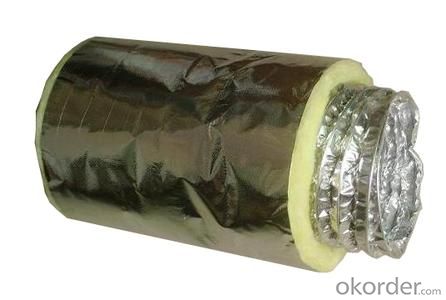

FAQ of Aluminium Flexible Duct:
1. What temperature maximum? Our products: 150℃ and 250℃
2. What MOQ? Our MOQ: 500 pcs
3. What payment terms? We accept T/T and L/C
4. Lead time: 10 days
5. Packing: Nest packing for non-insulated flexible duct, then into plastic bag for non-insulated flexible duct or packed in individual carton box.
- Q: What are the methods to ensure food does not adhere to aluminum foil while baking?
- <p>To prevent food from sticking to aluminum foil when baking, you can use a few methods. First, lightly grease the foil with cooking spray or oil before placing food on it. Second, consider using a non-stick spray or a light brushing of butter or oil directly on the food itself. Another option is to use parchment paper as a barrier between the food and the foil. Additionally, ensure the food is not overcooked, as this can cause it to stick. Lastly, avoid using shiny, new aluminum foil for acidic or sugary foods as it may react with the foil.</p>
- Q: This question asks for methods to keep aluminum foil facing from curling up after it has been used.
- <p>To prevent aluminum foil facing from curling up after use, consider the following tips: 1. Ensure the foil is cut straight and even to reduce the likelihood of curling. 2. Use a light coating of cooking spray or oil on the foil to help it lay flat. 3. Apply a thin layer of flour or cornstarch to the foil before placing food on it; this can help it adhere better. 4. Use a piece of parchment paper between the food and the foil to prevent direct contact and reduce curling. 5. Keep the foil taut and smooth before placing it in the oven or on the countertop. 6. If using in the oven, ensure even heat distribution to avoid hot spots that could cause the foil to curl. Regularly check and adjust the foil as needed to maintain its flatness.</p>
- Q: This question asks for a comparison of the differences among different types of plastic containers.
- <p>Plastic containers vary in material composition, durability, temperature resistance, and intended use. HDPE (High-Density Polyethylene) is sturdy and good for detergent bottles and milk jugs. LDPE (Low-Density Polyethylene) is flexible and used for plastic bags and film. PET (Polyethylene Terephthalate) is recyclable and used for water bottles and food containers. PVC (Polyvinyl Chloride) is durable but not food-safe due to potential leaching of harmful chemicals. Polypropylene is resistant to heat and acids, making it suitable for microwave-safe containers. Polystyrene is lightweight and clear but not microwave-safe and can release styrene, a harmful chemical, when heated. Each type has specific uses and properties that make it suitable or unsuitable for certain applications.</p>
- Q: What are the most effective ways to clean surfaces that have aluminum foil applied to them?
- <p>The best cleaning methods for aluminum foil facing involve gentle cleaning to avoid damaging the foil. Use a soft cloth or sponge with warm water and mild dish soap to wipe the surface. Avoid abrasive cleaners or scrubbing, as this can scratch or tear the foil. For stubborn stains, a mixture of baking soda and water can be applied as a paste and gently rubbed with a soft cloth. Always rinse thoroughly and dry the surface to prevent water spots and maintain the integrity of the aluminum foil.</p>
- Q: What are some lesser-known applications of aluminum foil in the kitchen?
- <p>Aluminum foil facing has several creative uses in the kitchen beyond just wrapping food. It can be used to cover baking dishes to prevent spills and messes in the oven, line baking sheets for easy cleanup, or create a makeshift roasting bag for cooking meats. It can also be used to sharpen knives by folding it into a book shape and running the blade through the sharp edges, or to create a non-stick surface for cooking by lining molds or baking pans. Additionally, it can be used to scrub pots and pans, removing stuck-on food, or to create a barrier between food and direct heat to prevent burning. These uses showcase the versatility of aluminum foil in the kitchen.</p>
- Q: Is it safe to use aluminum foil facing on lunch boxes for making sandwiches or wraps?
- <p>Yes, you can use aluminum foil facing to make sandwiches or wraps for lunch boxes. Aluminum foil is a common material used for food packaging due to its ability to keep food fresh and protected. It is non-toxic and does not react with most foods, making it safe for use in lunch boxes. However, it's important to ensure that the foil does not tear or come into direct contact with acidic foods, as this could potentially lead to the leaching of aluminum. Always handle food with clean hands or utensils to maintain hygiene.</p>
- Q: This question asks for methods to clean oil stains from the aluminum foil side of a material, likely referring to a type of laminate flooring or backsplash.
- <p>To remove oil stains from aluminum foil facing, first, let the stain dry completely. Then, use a mild detergent mixed with warm water to dampen a cloth and gently wipe the area. Avoid using abrasive cleaners or steel wool, as they can scratch the aluminum foil. For stubborn stains, you may apply a small amount of baking soda paste (baking soda mixed with water) and gently scrub with a soft cloth. Rinse thoroughly with water and dry the area. Always test cleaning methods on a small, inconspicuous area first to ensure no damage occurs.</p>
- Q: Describe the most effective methods for utilizing aluminum foil in baking processes.
- <p>The best way to use aluminum foil in baking involves lining the baking sheet to prevent food from sticking and to simplify cleanup. Preheat the foil by placing it on the sheet and heating the oven before putting in the food. For even cooking, ensure the foil doesn't touch the heating elements. Use foil to wrap foods like potatoes or fish for steaming, or create packets for en papillote cooking. When using foil to cover food, tent it loosely to allow for air circulation. For browning, remove the foil during the last part of baking. Always handle with care to avoid tearing and ensure椋熷搧瀹夊叏.</p>
- Q: How to properly handle aluminum foil when it is exposed to hot or cold temperatures.
- <p>When handling aluminum foil that is hot or cold, it's best to use tongs, a fork, or a pair of gloves to avoid direct skin contact. This prevents burns from hot foil or frostbite from cold foil. If the foil is being used in cooking, ensure it's not in direct contact with the heat source for prolonged periods to prevent melting. For cold applications, like insulation, make sure the foil is dry to maintain its effectiveness as a barrier. Always handle with care to prevent tearing or puncturing the foil, which could compromise its integrity.</p>
- Q: The user is asking if aluminum foil can be used to make a pizza crust more flaky and tender.
- <p>Using aluminum foil facing on a pizza crust won't inherently make it more flaky or tender. The flakiness and tenderness of a pizza crust are determined by the ingredients used and the method of preparation. For a flakier crust, consider using a higher fat content like butter or shortening, and for tenderness, ensure proper hydration and kneading of the dough. Aluminum foil is typically used for its heat distribution properties and to prevent direct contact with the oven rack, which can help in browning the bottom of the crust. However, it doesn't affect the flakiness or tenderness directly.</p>
Send your message to us
Aluminum Foil Facing Insulated Flexible Ductings HVAC Ducting for Air Conditioning
- Loading Port:
- Shanghai
- Payment Terms:
- TT or LC
- Min Order Qty:
- 500 pc
- Supply Capability:
- 50000 pc/month
OKorder Service Pledge
OKorder Financial Service
Similar products
Hot products
Hot Searches
Related keywords
